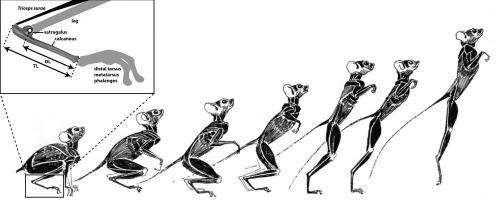Early primate leaping set stage for human airtime

(Phys.org) —Over a puddle, up to the basket, off the high dive—we all take leaps from time to time.
Now, new research suggests that this acrobatic lifestyle began far back in our evolution, when the earliest primates were first emerging on Earth.
"What this study suggests to us is that a very unusual and impressively acrobatic lifestyle jumping through the trees set us on the road to evolving many of features we recognize today in primates, including humans," says Duke evolutionary anthropologist Doug Boyer.
Boyer and colleagues measured the ankle bones of 73 living and 38 extinct species of primates and found that throughout primate evolution, even our earliest ancestors were developing the bone structure to support long jumps. The results appear July 3 in PLoS ONE.
From the data, the scientists concluded that the ankle mechanics for better leaping in primates began to evolve around 55-60 million years ago. Boyer says natural selection seemed to favor a lifestyle of increasingly acrobatic locomotion in trees, including leaping long distances rapidly between branches.
Scientists had previously noticed that exceptional leapers had unusually elongated ankles. Boyer's study, however, is the first to simultaneously test for effects of both body mass and behavior on ankle-bone elongation.
The team found a trade-off between body mass and ankle elongation. At larger body masses, ankles were proportionally shorter regardless of behavior. Yet, among animals of similar body size, the leapers had proportionally longer ankles, Boyer says. This was true among even fairly large primates, a contradiction to scientists' earlier view that there was no behavioral benefit of ankle elongation for bigger animals.

The study is also the first to look at incremental evolutionary changes leading from our earliest primate ancestors to all the modern living forms. Whether leaping was an important behavior for the earliest primates has been controversial.
From their fossil data, Boyer and colleagues could see that early primates were not specialized leapers. "For the most part many of them were generalists, clamoring around on trees, jumping around now and then, but possibly preferring to scamper rather than make huge leaps," he says.
This particular conclusion was not new. But the researchers' approach—looking at incremental evolution—allowed them to see more of a change. "The earliest primates were already better leapers than their ancestors, and the data show their descendents became even better yet," he explains.
The measurements also suggest that initial elongation of the bones for specialized leaping evolved two independent times in primates – once in lemur ancestors and once in the ancestor of tarsiers, monkeys, apes and other anthropoids like us.
The study didn't directly address human leaping, and it doesn't mean humans with longer ankles are better leapers. But, Boyer notes, it's not out of the range of possibility.
More information: Boyer, D. et al. Evolution and allometry of calcaneal elongation in living and extinct primates, July 3, 2013. PLoS ONE. doi: 10.1371/journal.pone.0067792
Journal information: PLoS ONE
Provided by Duke University


















